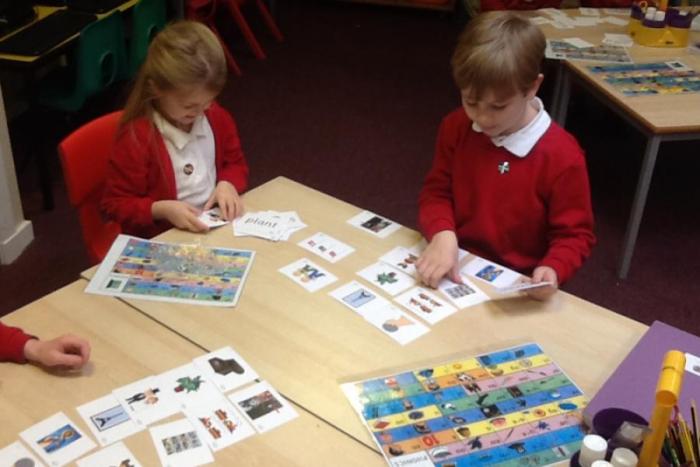Mrs Kleban is the class teacher and Miss Spalding is our HLTA
We are all thrilled to have the privilege of working with your children on the first steps of their educational journey and aim... more

Phonics Leader: Miss Lewis
Reading is given high priority at Broadbent Fold Primary School and Nursery; no other skill is more important than reading. It is the gateway to all other knowledge. If children do not learn to read efficiently, the path is blocked to every subject they encounter in their school years.
“The more that you read, the more things you will know. The more you learn, the more places you’ll go.”— Dr. Seuss, “I Can Read With My Eyes Shut!”
We are committed to teaching our pupils to become skilled readers who develop a comprehensive understanding of words, language and texts as they move through school. They learn to read and then read to learn. Our aim is to ensure that pupils develop a love of reading so that they can read for purpose and for pleasure. Moreover, reading for pleasure, often and with enthusiasm, lays the foundations for life; you interact, react, empathise and understand the tools to express yourself and interpret life. Can you remember the first book that truly 'hooked' you?
In our School we use First Class Phonics: We have a high-quality, consistent approach to the teaching of phonics. We use child-friendly resources so that all children are actively engaged and having fun whilst practising and applying phonics. Our phonics lessons help to develop children’s vocabulary and promotes a love of reading.The scheme is matched to and exceeds the expectations of the EYFS ELGs and National Curriculum for Reading in KS1.First Class Phonics prepares children for success in the Phonics Screening Check and beyond.We have high expectations for developing early reading, spelling and writing. First Class Phonics enables children to immediately apply their new learning into reading or spelling within the phonics lesson.We have Is also matched to the most commonly-used phonically decodable reading schemes – meaning you can still use all your existing phonically decodable books.First Class Phonics teaches children to produce phonemes with accurate pronunciation. Pure pronunciation is essential for accurate blending.Children are taught to ‘sound out’ and blend through extensive teacher-pupil interaction going from highly supported to independence.
First Class Phonics has a structured progression for teaching graphemes which slows down the pace of teaching but increases the pace of the learning. With First Class Phonics, there is time to teach and practise but there is also time to revisit and embed.
There is a systematic progression for teaching word structures, sentence structures, sentence types which matches up with expectations in the most widely-used phonically decodable reading schemes.
First Class Phonics provides every child with the opportunity to practise reading a range of words in every session.
Children are actively engaged in their own learning by taking part in a familiar range of ‘hands-on’ activities using Pupil Sets of word and picture cards. These activities provide opportunities for children to practice reading and also develop key skills: how to share, take turns, listen to each other and collaborate.
We prioritise active learning so every child can participate in activities during the practice part of the lesson. No more lessons where a few children are involved and the rest just ‘look on’.
In the First Class Phonics lesson, our children learn to decode High Frequency Words using their phonic knowledge with the help of a loveable puppet – Izzy the Busy Bee! Izzy is always very busy because there are so many HFW words!
FCP teaches children how to read and spell common exception ‘tricky’ words, using another loveable puppet – Trevor the T-Rex! Trevor is tough enough to cope with ‘tricky’ words!
First Class Phonics develops children’s vocabulary using another cuddly puppet – Luna the Moon Unicorn. Luna introduces challenge through her ‘Unicorn’ words – uncommon real words. She helps children to be ready for the Phonics Screening Check as her Unicorn words are the type of real words that appear in the Check.
Luna also helps children to decode Alien words, thereby applying all of their phonic knowledge and skills. Children love to learn with these ‘phonic friends’!
First Class Phonics provides a direct link between reading and writing through the weekly teaching sequence. This means that children always learn to read words before being asked to spell them!
Teachers teach new vocabulary using engaging picture prompts. These same picture cards are used during dictation as a visual prompt and concrete link to the dictated word.
With First Class Phonics, there is an emphasis on using manipulative resources in Reception for spelling – before children in EYFS are ‘ready to write’. Although some children may not have developed the physical skills required for handwriting, they will have the phonic skills and understanding required to spell words and short phrases with magnetic letters or letter cards. Our spelling activities can be differentiated to allow all children to make progress in their spelling regardless of their physical development or learning needs.
Spelling lessons always provide opportunity for teachers to teach spelling through dictation and for children to practise spelling using fun, engaging activities.
Teachers also dictate sentences so children can apply their learning into writing a meaningful caption to match a picture prompt. This picture also provides a concrete link to the dictated sentence.
First Class Phonics provides a clear progression so that children are taught how to spell Common Exception Words: Izzy the Busy Bee’s High Frequency words (phonically decodable) and Trevor’s Tricky Words.
Captions have been specially written to provide opportunity for children to regularly practise spelling these Common Exception Words within phrases and sentences. There is a structured progression for these captions which includes sentence types, sentence structures and grammatical features linked to the Year One and Two National Curriculum.
https://bced.co.uk/firstclassphonics/what-is-first-class-phonics/